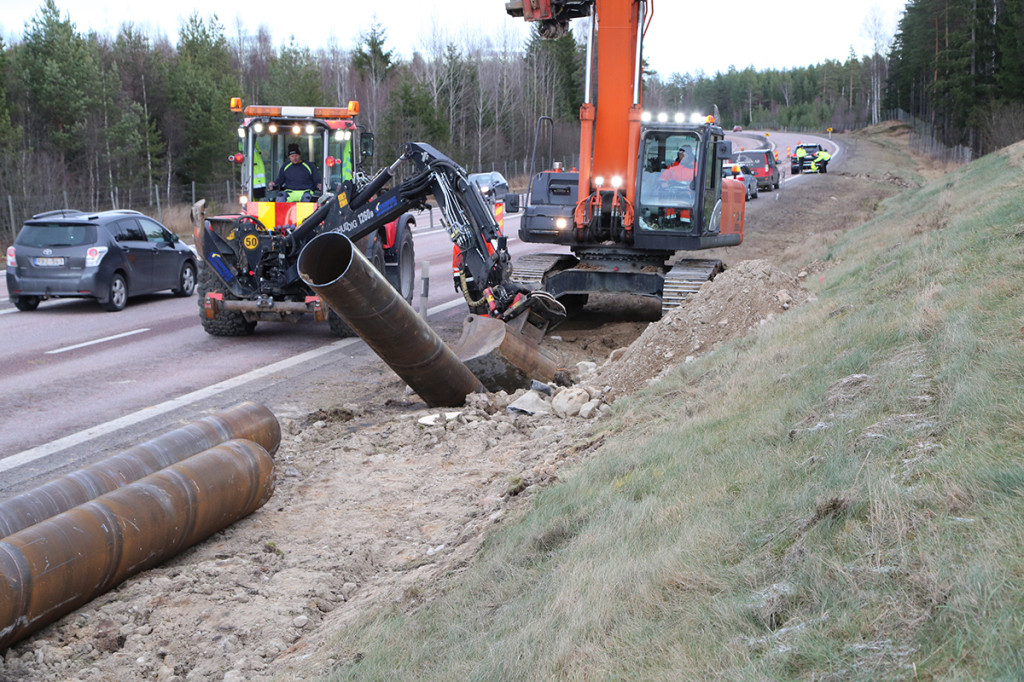Electric roads enable the transport sector to be powered by a broad green-energy base of wind, solar, and hydro power. Having stakeholders and policymakers with the courage to make the commitment, Sweden has an opportunity to be a trailblazer. Tests and demonstrations are underway in the Swedish project Electric Road Procurement to expedite the development process.
Fossil fuel use must decrease, and quickly. At the same time, shipments of goods by road are expected to grow by 59% between now and 2030. It is unlikely that much of that volume could be shifted to railroads, as that would entail the expensive and time-consuming expansion of the railway system. Maritime shipping can handle some of that volume, but will not suffice.
“Freeing transport by road from its dependence on fossil fuels must be achieved mainly through measures undertaken within the road transport system”, says Anders Berndtsson of the Swedish Transport Administration.
Several solutions, such as biofuels, electrification, and improved efficiency, must be combined to reduce carbon dioxide emissions from lorry shipments. The Swedish Transport Administration can contribute most significantly through the electrification of roads, which reduces energy use and carbon dioxide emissions based on solutions using existing infrastructure.
“It takes time to change systems. We now have to test and demonstrate in order to broaden our knowledge and increase maturity and acceptance of new transport technology”, says Berndtsson.
The Electric Road Procurement Project, a pre-commercial innovation procurement process being conducted cooperatively by the Swedish Transport Administration, the Swedish Energy Agency, Vinnova, and Swedish industry, began in June 2013.
One of its aims is to study whether the considered transmission technologies will work in real traffic, and whether they are safe and reliable or need to be improved.
Testing conductive transfer technology at Arlanda
Several demonstration projects are already underway. Two consortia have begun electrifying existing roads, i.e., E-road Arlanda and Elväg Gävle.
“On E-road Arlanda, a solution has been chosen that involves conductive transfer technology from below, i.e., a rail with electrical conductors in sections that are energised whenever a car passes. Multiple safety barriers minimise the risk of accidents”, explains VTI Deputy Research Director Sofia Lundberg.
In the first phase, a 350-metre test track has been built. A groove is first cut, after which rails are laid in 12-metre sections and assembled. According to Lundberg, snow and ice have not been a problem.
“We plough using regular snowplough vehicles with a special shoe gear coupled behind the vehicle. In addition, all the rails have built-in heating coils that can, on rare occasions, be turned on if it is extremely cold, for example, in Northern Sweden.
During the year, the project group will run safety verification tests, and a decision on how to continue will be made in the fall. Plans call for an electric road to be laid between Arlanda and the PostNord terminal in Rosersberg in the spring of 2017. This will mean that PostNord’s Green Flight aircraft will land at Arlanda, after which the freight will be driven by electric road to Rosersberg, processed in a green-building terminal equipped with one of Sweden’s biggest solar cell parks, and then loaded onto trains directly from the terminal.
“Climate-smart logistics solutions every step of way. This is how we need to think of freight management in the future”, says Lundberg.

Example of conductive transfer technology from below, which is being used in the E-road Arlanda demo project. Photo: Erik Mårtensson.
Electric road with overhead lines
“Demand for shipping is increasing, and lorries play a key role. Electrified heavy logistics will become considerably cheaper than at present, which will drive growth and employment. On the other hand, a failure to meet industry demand for capacity could force production out of the region or out of Sweden”, says Jan Nylander, Region Gävleborg.
This is one reason why the Gävleborg region has decided to invest in a research project involving electric roads outside the city of Sandviken. The project consists of laying two kilometres of electric road on E16, where an electrically powered lorry weighing 60 tonnes will be driven in normal traffic for two years. The electric road is being built using tram technology, i.e., with the electricity provided via overhead lines.
“Large amounts of energy are not necessary, so we don’t need to expand the power companies or the like to power the road. In the event of a temporary outage, the lorry has a small diesel engine”.
The project began in December 2015 and is a cooperative effort involving a large number of actors, who are also developing ways of disseminating information about climate-smart logistics in Sandviken. The road is scheduled to be dedicated in June 2016, and testing using commercial loads will commence as soon as feasible.
“Based on our experience of installing and operating electric roads on normal roads, the project will then provide a basis for decision-making that will contribute to the electrification of our major shipping routes”, explains Nylander.
Gävleborg region intends to electrify relevant parts of the triangle of cities comprising Gävle, Borlänge, and Avesta. This could contribute to robust regional development, growth, and welfare by boosting the industry’s profitability and capacity in terms of investments, recruitment, and exports. Another project goal is to actively promote the development of climate-smart logistics and contribute to the national effort to assess, implement, and benefit from electrified road infrastructure.
 Contact: Contact:Sofa Lundberg, Deputy Research Director sofia.lundberg@vti.se VTI, Sweden |
This article is a report from the VTI conference Transportforum 2016. You find more information about the conference here (in Swedish).







Follow us: